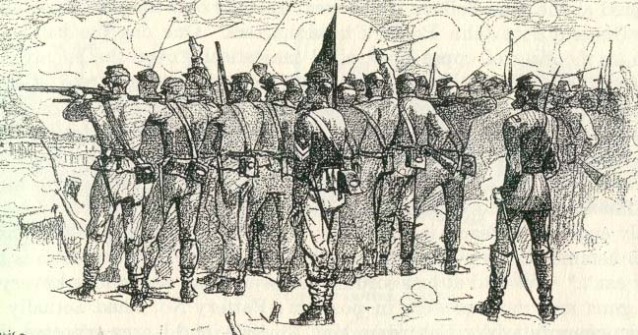Sketch by Winslow Homer
In Civil War tactics, the principal combat arm was infantry. Its most common deployment was a long “line of battle,” 2 ranks deep. More massed was the “column,” varying from 1 to 10 or more companies wide and from 8 to 20 or more ranks deep. Less compact than column or line was “open-order” deployment: a strung-out, irregular single line.
Battle lines delivered the most firepower defensively and offensively. Offensive firepower alone would not ensure success. Attackers had to charge, and massed columns, with their greater depth, were often preferable to battle lines for making frontal assaults. Better yet were flank attacks, to “roll up” thin battle lines lengthwise. Offensive tacticians sought opportunity for such effective flank attacks; defensive tacticians countered by “refusing” these flanks on impassable barriers. In either posture, tacticians attempted to coordinate all their troops to deliver maximum force and firepower and to avoid being beaten “in detail” (piecemeal). Throughout, they relied on open-order deployment to cover their front and flanks with skirmishers, who developed the enemy position and screened their own troops.
Open order, moreover, was best suited for moving through the wooded countryside of America. That wooded terrain, so different from Europe’s open fields, for which tactical doctrine was aimed, also affected tactical control. Army commanders, even corps commanders, could not control large, far-flung forces. Instead, army commanders concentrated on strategy. And corps commanders handled “grand tactics”: the medium for translating theater strategy into battlefield tactics, the art of maneuvering large forces just outside the battlefield and bringing them onto that field. Once on the field, corps commanders provided overall tactical direction, but their largest practical units of tactical maneuver were divisions. More often, brigades, even regiments, formed those maneuver elements. Essentially, brigades did the fighting in the Civil War.
Besides affecting organization, difficult terrain helped relegate cavalry and artillery to lesser tactical roles. More influential there was the widespread use of long-range rifled shoulder arms. As recently as the Mexican War, when most infantry fired smoothbore muskets, cavalry and artillery had been key attacking arms. Attempting to continue such tactics in the Civil War proved disastrous, as infantry rifle power soon drove horsemen virtually off the battlefield and relegated artillery to defensive support. Rifle power devastated offensive infantry assaults, too, but senior commanders, who were so quick to understand its. impact on cannon and cavalry, rarely grasped its effect on infantry. By 1864, infantry customarily did erect light field fortifications to strengthen its defensive battlefield positions and protect itself from enemy rifle power; but when attacking, whether against battle lines or fortifications, infantry continued suffering heavy casualties through clinging to tactical formations outmoded by technology.
Source: “Historical Times Encyclopedia of the Civil War” Editor, Patricia L. Faust


I was looking through some of your posts on this internet site and I think this website is really informative! Retain posting.